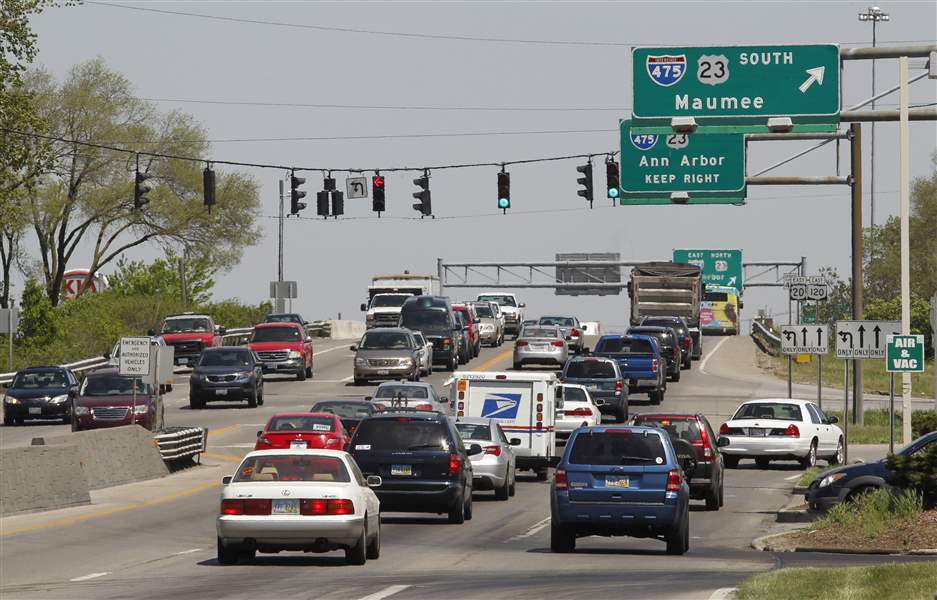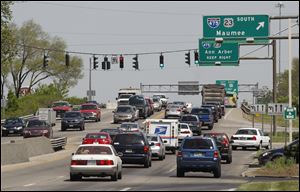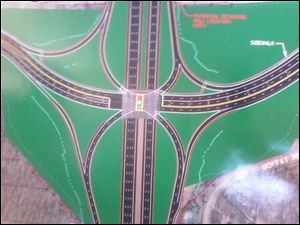
I-475 interchange plan divides Central Ave.
State wants radical intersection, median
5/16/2013
To reduce congestion, the Ohio Department of Transportation plans a median down Central Avenue at I-475/U.S. 23.
THE BLADE/LORI KING
Buy This Image

To reduce congestion, the Ohio Department of Transportation plans a median down Central Avenue at I-475/U.S. 23.
A revolutionary “single-point” interchange is the focus of state plans to ease congestion and reduce crashes at the Central Avenue interchange with I-475/U.S. 23, but a planned median divider on Central east of the freeway got the most attention from nearby residents during an “open house” meeting held Wednesday evening.
“That’s going to be so hard for people who go to work,” said Andrea Clarkson, a co-owner of Community Internet Service Providers on Moffat Road, which would become right-in, right-out on the eastbound side of Central if the Ohio Department of Transportation goes forward with the plans that were presented during the three-hour session at the Sylvania Township Hall.
“We live in this neighborhood. We need to get to our houses,” said Glenn Holmes, who lives farther south on Moffat — although his house is one of two that ODOT officials said they may condemn to realign the northbound exit to Central.
The median, running east to Holland-Sylvania Road with a gap and traffic signal at Fairbanks Avenue, would be similar to one built last decade on Central west of I-475 to McCord Road.
West of the freeway, the project would disconnect Plainview Drive from Central Avenue. Plainview, which shares Central’s intersection with the southbound freeway ramps, would become a cul-de-sac.
For Plainview resident Chris Salverstrom, that change will be “kind of a double-edged sword.” “We will lose the cut-through traffic on Plainview, but lose access [to Central and the freeway], too,” she said.

Proposed interchange uses minimal real estate, makes left turns simpler.
“My granddaughter will be able to ride her bike in the street now,” she added.
The centerpiece of the project, which ODOT officials expect to cost $40 million to $50 million and hope to build between mid-2015 and mid-2017, is the single-point urban interchange at which all four left-turn moves between the freeway ramps and Central would occur at a central location, rather than at two intersections with separate traffic lights.
The project “addresses capacity and safety in this area, and sets us up for future widening of the corridor,” said Todd Audet, the department’s district deputy director in Bowling Green.
Michael Stormer, the district planning engineer at the district office, said the median on Central east of the freeway is planned to manage traffic and reduce crashes at unsignaled streets and driveways.
The Fairbanks intersection was chosen for a stoplight and break in the median, Mr. Stormer explained to several residents, because it’s about halfway between I-475 and Holland-Sylvania. He encouraged them to fill out comment forms to make their cases that Moffat should get the signal instead.
Besides discussing its impact on local traffic, several meeting participants inquired about possible construction of noise walls along the freeway near Central. State officials said they are studying wall construction between Bancroft Street and Blossman Road, but not north of Blossman, where a separate project planned to start next year will rearrange part of the I-475 and U.S. 23 junction.
ODOT expects to need minimal lane and ramp closings while constructing the new interchange, which is to be built just south of existing Central Avenue. Some temporary ramps will be necessary during construction, Mr. Stormer said.
Contact David Patch at: dpatch@theblade.com or 419-724-6094.